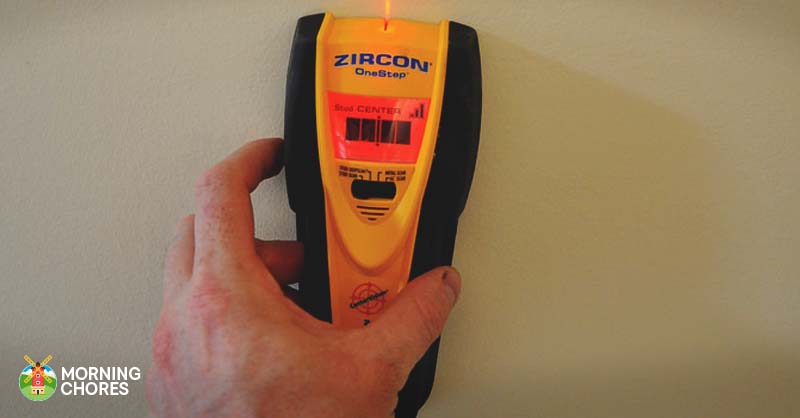A stud finder is an excellent tool for when you need to hang up a picture, install a new set of shelves, or mount a new television on the wall. Many houses contain timber framing inside the drywall or plaster, and the framing has studs attached to the timber.
So when you hammer a nail into the wall, the nail can end up making contact with the stud which can cause the picture or whatever you want to hang up on the wall to fall off as the study cannot support its weight. A stud finder can help you to accurately locate where the studs are hidden behind the wall so that you can safely complete your task.
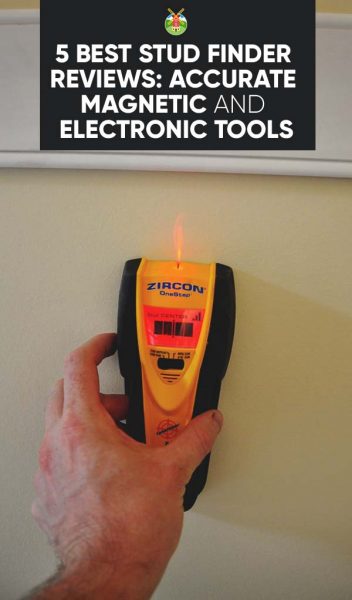
The 5 Best Stud Finders
- CH Hanson 03040 Magnetic Stud Finder
- Studpop Magnetic Stud Finder
- Franklin Sensors FS710 ProSensor Stud Finder (Our Top Pick)
- Zircon Stud Finder Pro A250 Multiscanner
- Tavool Stud Finder
Our Top Pick for the Best Stud Finder
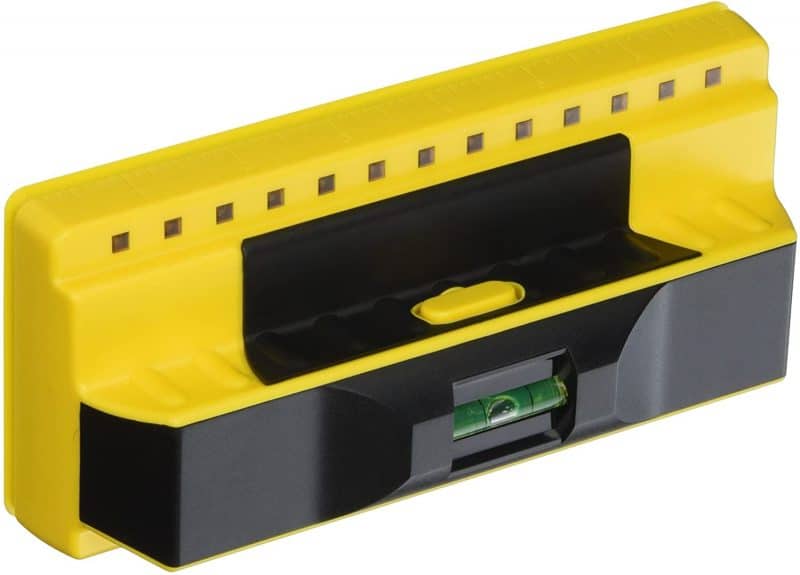
Our top pick for the best stud finder is the Franklin Sensors FS710 ProSensor Stud Finder.
With a simple but very effective scanning approach, the ProSensor Stud Finder uses the latest technology to accurately detect the presence of studs that are located behind most types of building materials like drywall, plaster, and sheetrock. It might not have the extra bells and whistles like other high-tech stud finders and it is a little more expensive, but it is very quick and easy to use.
The LED lights illuminate when you have located those hard-to-find studs, and it has an extra built-in bubble level and a ruler.
Check the price on AmazonHow Does a Stud Finder Work?
A stud finder can register the presence of a stud or detect the change in the density of the material behind the wall to show you exactly where each stud is, either a wood or steel stud, depending on the construction of your house.
It can also help you to detect other elements inside the wall such as electrical wiring and pipes. By investing in a high-quality, accurate stud finder, you can safely attach shelving or other heavy items without having to worry that your chosen item may fall off the wall, which can result in expensive damage to your home or a serious accident.
Locating wall studs can be time-consuming and may require some practice, so this video tutorial will teach you how to use a stud finder.
How to Choose the Right Stud Finder for You
There are two types of stud finders: magnetic and electronic.
Magnetic Stud Finders
A magnetic stud finder has a simple design. It is an ideal tool for basic DIY projects around your home like hanging a picture or the occasional home maintenance task. This type of finder is the most affordable. A magnetic finder uses industrial-strength neodymium “rare earth” magnets to detect nails and screws that are attached to the studs behind the wall.
Magnetic finders such as the Studpop Magnetic Stud Finder look like a chess piece with a brightly colored knob in the middle. When it detects a stud, the knob pops out. Some magnetic finders, such as the CH Hanson 03040 Magnetic Stud Finder has an extra feature, a rotating bubble vial that helps you to make accurate plumb alignments for horizontal and vertical leveling precision as well as locating studs.
While a magnetic finder is very easy to use and a great portable and lightweight option that can fit into your pocket, it may not be able to give you an accurate reading through thick wall construction material. It is not recommended for use on walls that have piping or wiring.
Electronic Stud Finders
If you are a professional tradesperson or you do a lot of DIY home maintenance or renovations, invest in an electronic stud finder. This type of finder tends to be more expensive. However, it is a very smart all-around device that goes one step further than a magnetic stud finder.
An electronic stud finder utilizes the latest technology to seek out and detect studs that are hiding behind the wall. It can also register the density changes in the wall. An electronic stud finder can provide multiple modes of scanning and can detect studs, AC wiring, piping, and live current behind walls and even the ceiling and floor. It can be used on most building materials such as plaster, lath, and sheetrock.
However, it may give you a negative scanning with sheetrock that has two layers. So you may have to scan more than once.
Electronic stud finders such as the Franklin Sensors FS710 ProSensor Stud Finder features Triple Accuracy Technology with 13 sensors that can find hidden studs quickly, even in the material that is up to 5/8-inches thick.
Some units look like a television remote and have a lot of extra features. In addition to being able to provide four different types of scans: general scan, deep scan, metal scan, or AC scan, it has an LCD screen that shows you the signal strength of the stud so that you can distinguish between shallow and deep targets. It also alerts you with an audio and visual alert when it has located the stud.
Compared with magnetic stud finders requiring no calibration, where you just attach them to the wall and their powerful magnets detect metal fasteners on the stud, most electronic stud finders need to be calibrated once they have been attached to the stud wall’s surface. However, calibration should only take a few seconds.
– Automatic Calibration
Some electronic finders have automatic calibration and use Auto Correcting Technology to give you quick and easy detection if you are a professional tradesman. So you can locate the studs and then spend your valuable time on completing your project.
– Battery Power
Electronic stud finders need a 9-volt battery to function. A 9-volt battery provides long-lasting power. However, its battery life will depend on how often you use the stud finder. So you may need to stock up on extra batteries if you are working on a big project.
5 Best Stud Finders – Reviews
1. CH Hanson 03040 Magnetic Stud Finder
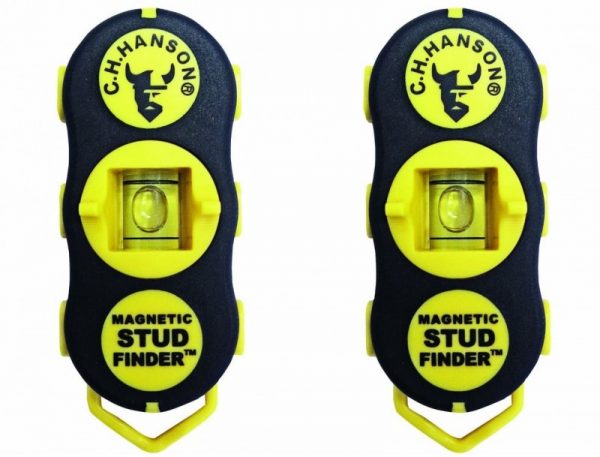
CH Hanson is one of the most trusted manufacturers of non-powered hand tool products designed for use in the industrial, construction, safety, and hardware/DIY consumer markets. So you are guaranteed that it can deliver accurate results every time. This very effective CH Hanson 03040 Magnetic Stud Finder has a simple design but it is one of the best stud locating devices on the market.
It requires no batteries or calibration. It is also very durable so it can be used in all types of construction or home-based maintenance conditions.
The magnetic finder is very easy to use: just place the finder on the wall and sweep it in an “S” pattern to locate any nails or screws that have been fastened into studs behind the wall. Once you feel a strong pull, you have located a stud so you can safely attach your picture or shelving.
The secret to its success is that the finder uses rare industrial-strength Neodymium earth magnets to detect nails, screws, and other materials. The stud finder has 3 anchor points on each side for easy leveling and a rotating bubble vial that gives you accurate plumb alignments for horizontal and vertical precision, which makes it easy to mark the spot where the studs are located.
It can also be used on walls that have a ¾-inch thickness and it will not give any false readings. It is small and compact and fits easily in your pocket. The ergonomic shape with a soft grip fits comfortably in your hand.
Pros
- Ideal for small DIY and construction jobs
- Great value for money
- Excellent accuracy at locating studs
- Very reliable
- Durable
- Super strong magnets
- Small and compact
- Easy to use
Cons
- Not ideal for large jobs
- Takes some getting used to
2. Studpop Magnetic Stud Finder

This cute magnetic Studpop Magnetic Stud Finder is proudly made in the US and it is a fun and super-easy way of detecting magnets. As the finders come in a range of attractive colors, they may even encourage your kids to get involved to play Spot that Stud In the Wall!
The Studpop Magnetic Stud Finder is designed to work on any kind of wall: sheetrock, plaster, lath, and plaster. As it is shaped like a chess piece with an inner knob in the middle, it can locate any stud fasteners behind the wall fast. Just sweep it across the wall and once it detects metal, the knob springs upright. And all you have to do is make a pencil mark where the stud is and then move to the next one.
Or you can buy 3 or 4 of these stud finding devices and line them up across the wall to save time.
The Studpop stud finder is a simple and compact device that will ensure that you never miss a stud again. It also fits easily in your pocket. It is a good value for money and it needs no batteries. You do not have to wait for calibration, so the device is always ready to go. It is also very accurate.
Pros
- Very effective at detecting stud fasteners
- Ideal for general home-based DIY tasks
- Works on sheetrock, plaster, lath, and tile
- No batteries required
- No calibration necessary
- Easy to use
- Various colors
- Compact size
Cons
- Expensive
- Not ideal for professional or large construction jobs
- Does not work very well on thick wall construction
3. Franklin Sensors FS710 ProSensor Stud Finder

This handy 2-in-1 patented electronic Franklin Sensors FS710 ProSensor Stud Finder guarantees you a high accuracy detection rate every time. It contains 13 powerful sensors that can register a deeper level of stud sensing than other scanners. Franklin Sensors have designed their finder with Triple Accuracy Technology that analyzes and triangulates data from all the sensors so that you can find hidden studs quickly.
The stud finder can be used on most building materials such as plaster, drywall, lath, and sheetrock. However, if your home has been built with two layers of sheetrock, the device may give off negative scanning results. So you may have to re-scan.
With an easy one-step operation, it saves you time. You do not need to slide the device across the wall, just press the button and the LED lights illuminate instantly when studs are located. It can locate both the center and edges of the stud at the same time. The ProSensor 710+ has a super extra feature: a built-in bubble level and ruler to make sure that you get your leveling and measurement right every time.
As it is made from lightweight plastic, you can carry it around while you work.
To make sure that your stud finder lasts you for years, be careful when you are using it as the finder can break if you drop it from a great height. Also, make sure that you hold the button down so that can get an accurate reading. There is a manufacturer’s warranty which can be requested from customer service. Franklin Sensors has an excellent customer service team, which can help you with all your product queries.
Pros
- Very efficient
- High accuracy
- Two-in-one tool: stud finder and a built-in bubble level
- Does not require calibration
- Provides a deeper level of sensing
- Designed with Triple Accuracy Technology
- Ideal for use on plaster, drywall, lath, and sheetrock
Cons
- Expensive
- Not ideal for walls with two layers of sheetrock
4. Zircon Stud Finder Pro A250 Multiscanner
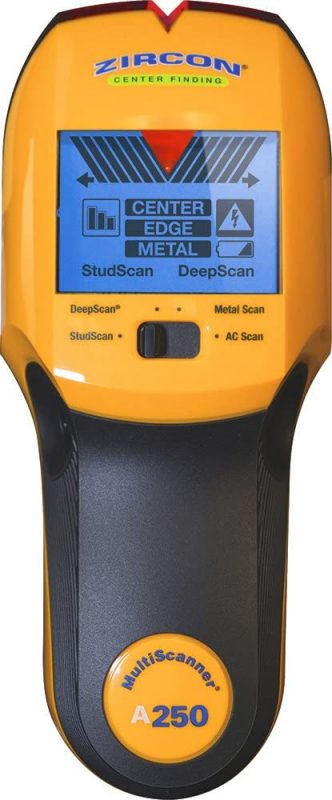
If you need a new stud finder for your new construction project or DIY renovations around your home, invest in the Zircon Stud Finder Pro A250 Multiscanner. As one of the most highly versatile scanners on the market, the Zircon A250 MultiScanner will help you to safely complete home renovations or maintenance projects.
The stud finder has an LCD backlit display and its smart system can accurately locate the center and edges of wood and metal studs behind walls, floors, and ceilings. Once it has detected the stud, it alerts you with an audible beep. Auto-correcting calibration technology and a laser pointer guarantee a higher level of stud finding performance.
The scanner is one very handy tool for tradespeople, DIY enthusiasts, and carpenters as it has 4 scanning modes (stud scan, deep scan, metal scan, and AC scan). Its innovative wire-warning detection system indicates the presence of live, unshielded electrical wiring, so you do not have to worry about drilling into live wires.
Although it can scan through most materials, it might be difficult for the Zircon MultiScanner A250 to locate studs through extra thick plaster or other building material. Accuracy can be compromised if the battery is not fresh, so always check the battery’s expiry date and keep an eye on the low battery indicator on the screen.
Pros
- Very good quality
- Ideal for tradespeople and home-based carpenters
- Multi-mode scanner: 4 scanning modes
- Locates the center and edges of studs
- Ideal for metal and wooden studs
- Dual detection system: audio tone and laser pointer
- Auto-correcting calibration technology
Cons
- Takes some getting used to
- May not detect studs in very thick walls
5. Tavool Stud Finder
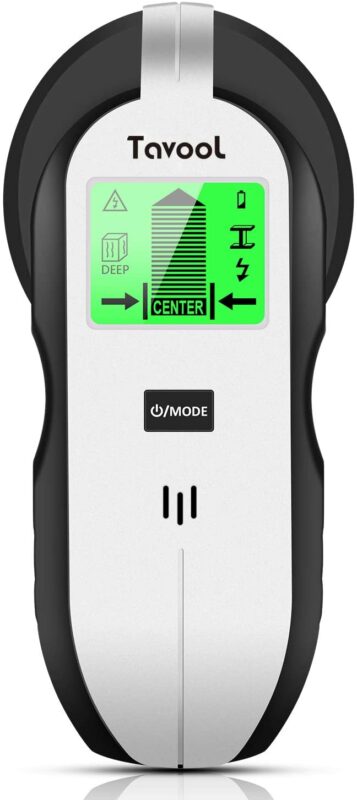
With a host of great features such as 4 different scanning modes, a good-sized LCD screen, and an alert signal that pings when the device has located the type of stud you are looking for, the super-smart silver-colored Tavool Stud Finder is the ideal scanning tool for carpenters and home-based maintenance tasks.
The wall stud finder can perform four different tasks: it can scan for studs in wood, metal, AC wiring. It can also provide deep scanning for hard-to-locate studs in drywall. For fast and precise detection and measurement accuracy, the device has automatic calibration.
The LCD screen displays all of the scanning information in easy-to-read graphics and shows the direction of the target as well as alerting you with an audible alarm when a stud, pipe, or live wiring has been detected.
The stud finder is very easy to use. Select what you want to scan for, hold the unit against the wall and press the middle button. It will beep when it is ready. Scan horizontally along the wall to find the edge of a stud or the presence of pipes or wiring and the scanner will make a beeping sound that gets loud when the device has indicated the stud’s precise location.
The stud finder also has arrows that are located on either side of the target indication bar on the screen, which guides you to the location of the stud, so you can quickly mark the location point with a pencil and move on to the next stud.
This multi-scanner looks just like a cell phone. Its ergonomic design allows it to fit comfortably in your hand. It is powered by a 9-volt battery that gives you long-lasting power.
Pros
- High quality
- Very effective
- Affordable price
- Good sized LCD screen
- Easy to read graphics
- Four scanning modes: metal and wood studs, pipes, and live wiring
- Detection strength displayed on the screen
- Detection alert tone
Cons
- May provide inconsistent results if there are many studs located side by side
Our Top Pick for the Best Stud Finder

Our top pick for the best stud finder is the Franklin Sensors FS710 ProSensor Stud Finder.
With a simple but very effective scanning approach, the ProSensor Stud Finder uses the latest technology to accurately detect the presence of studs that are located behind most types of building materials like drywall, plaster, and sheetrock. It might not have the extra bells and whistles like other high-tech stud finders and it is a little more expensive but it is very quick and easy to use.
The LED lights illuminate when you have located those hard-to-find studs, and it has an extra built-in bubble level and a ruler.
Check the price on Amazon